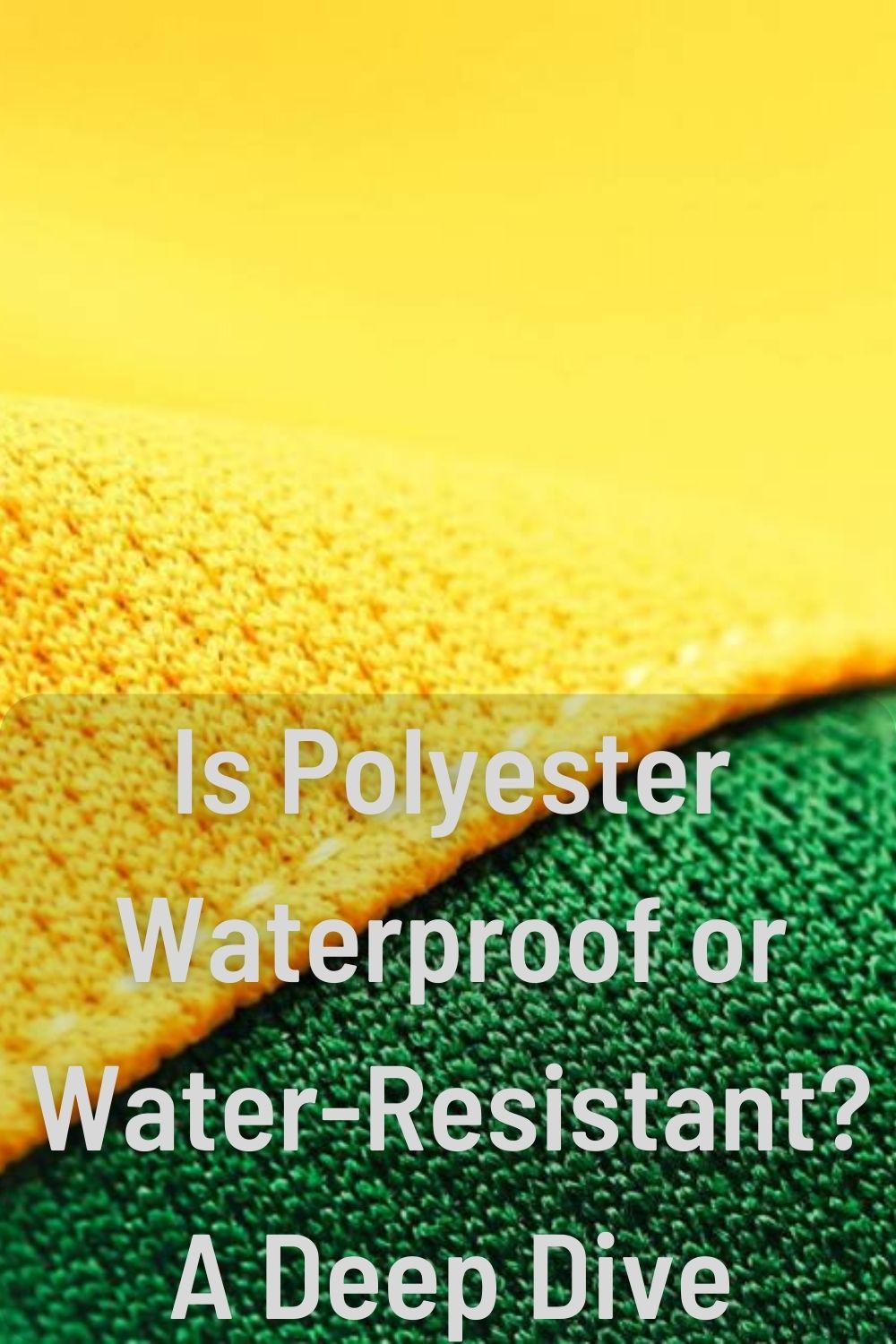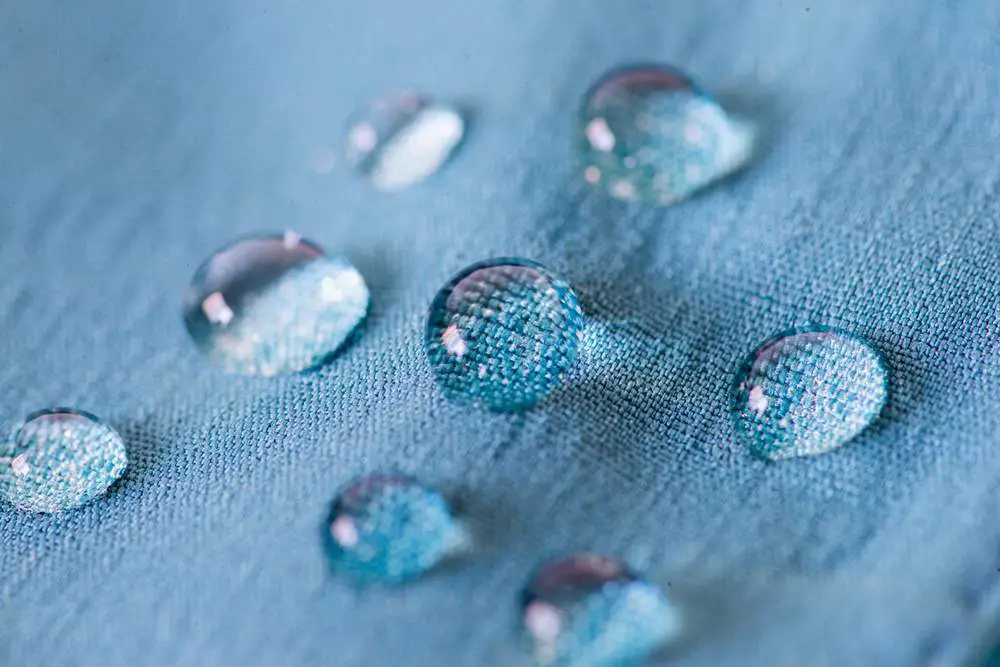
Polyester is ubiquitous in today’s world of textiles and fabrics. This synthetic material can be found in everything from clothing and home furnishings to outdoor gear and industrial applications. But one key question many consumers have is – how water-resistant is polyester actually? Is it waterproof? Or does it only provide moderate protection against moisture? We will examine polyester’s water barrier properties in great detail here.
Table of Contents
The Short Answer
In short: Polyester itself is water-resistant, not fully waterproof. However, with additional chemical treatments and coatings, polyester can be made into a waterproof fabric.
Uncoated polyester repels water nicely, but allows it to pass through with continuous exposure. Coated polyester blocks virtually all water droplets from penetrating the fabric.
So standard polyester is water-resistant. But enhanced polyester can achieve true waterproofing for harsh conditions.
What Is Polyester Made Of?
To understand polyester’s water capabilities, we must start by looking at the raw material itself. Polyester is made up of polymers – long chemical chain molecules fused together through a process called polymerization.
The most prevalent type of polyester is polyethylene terephthalate, commonly abbreviated as PET. PET polyester is made up of the polymers ethylene glycol and terephthalic acid.
Polymer chains used to create polyester fabrics have high bonding forces holding them together. This gives the material its signature durability and resistance to degradation.
Why Does Polyester Repel Water?

There are two key reasons why polyester fabric is intrinsically water-resistant:
1. Hydrophobic Polymer Structure
The polymers used to create polyester have a hydrophobic structure, meaning they repel water. The molecular bonds between the chain links prevent water droplets from fully adhering to or soaking into the polyester.
This hydrophobic quality makes polyester inherently water-resistant. Water beads up and rolls off the fabric instead of penetrating the fibers.
2. Tight Weave
Polyester fabric is woven very tightly with little space between the thread fibers. This offers fewer openings for moisture to seep through compared to more loosely woven cloths.
The snug structure obstruct water droplets from passing across the surface and entering the fabric interior. So water tends to collect on top rather than soak in.
Advantages of Polyester for Water Protection
Beyond its intrinsic hydrophobic weave, polyester offers other advantages when water exposure is a key factor:
- Quick drying – Polyester fabric dries rapidly even after getting wet. It doesn’t stay saturated like natural fibers such as cotton or wool.
- Mold/mildew resistant – The synthetic fibers inhibit mold or mildew growth, even when damp.
- Breathable – Allows sweat and vapor to escape, preventing interior condensation buildup.
- Durable – Resists damage from moisture and maintains integrity over time and use.
- Colorfast – The dye holds well when wet; colors don’t bleed or transfer easily during washing.
These characteristics make polyester a versatile fabric when dealing with potential water contact, from outdoor jackets to boat sails. It performs better in these situations than many natural textile options.
What Factors Impact the Water Resistance?
Not all polyester demonstrates the same level of performance when it comes to repelling water. Several factors affect the degree of water resistance:
- Weave – More tightly woven polyester blocks water better than a looser weave with bigger gaps.
- Weight – Heavier polyester material is more water resistant than lighter fabric.
- Finishings – Special coatings or chemical finishes enhance polyester’s natural water resistance.
- Type – Industrial polyester may provide better protection than consumer textiles.
- Use/Age – Over time, worn polyester can lose some of its water resistance as the fibers degrade.
Understanding these nuances allows one to select the right polyester based on the intended application and exposure to moisture expected.
Is Polyester Truly Waterproof?
While polyester is highly water-resistant, it does not offer true waterproofness like some other synthetic textiles. For a fabric to be fully waterproof, it must keep water from passing through the material – even when exposed continuously.
Uncoated polyester does allow water to seep through after an extended period of contact. Eventually water will find cracks and openings to traverse the fabric.
So while polyester is water-resistant, repelling water nicely, it is not impenetrable to moisture like certain laminated or coated fabrics. Significant water exposure will lead to polyester absorbing water over time.
Making Polyester Waterproof
If 100% waterproofing is needed, polyester can be enhanced in two primary ways:
1. Polyurethane (PU) Coating
By coating polyester with a layer of polyurethane, the fabric can be made fully waterproof. Polyurethane is a hydrophobic polymer that creates a protective barrier preventing any water from passing the fabric exterior.
PU coatings are typically applied as a thin film to the surface. This maintains the handfeel and breathability of the base polyester. Polyurethane-coated fabrics are used for rainwear, outerwear, and furniture.
2. Laminated Membrane
Polyester can also be laminated with an internal membrane layer made of a waterproof yet breathable material. Popular membrane fabrics include polytetrafluoroethylene (PTFE), Gore-Tex, Sympatex, and polyurethane.
This membrane is bonded to the inside of the polyester fabric, forming a sandwich structure. The membrane blocks all external water while allowing internal water vapor to escape.
Laminated polyester retains its natural feel and mobility while preventing any moisture from the outside from entering. This method provides durable waterproofing for the life of the product.
| Fabric Type | Water Resistant | Waterproof |
|---|---|---|
| Uncoated Polyester | Yes | No |
| Coated Polyester | Yes | Yes |
| Laminated Polyester | Yes | Yes |
In summary, coatings and lamination processes can convert polyester into a fully waterproof material, whereas basic polyester alone is merely water-resistant.
Polyester Uses Based on Water Protection Needs
The degree of water resistance required determines the optimal polyester type and application:
Water-Resistant Polyester Uses:
- Blouses and dresses
- Bed sheets
- Upholstery
- Tablecloths
- Light jackets
- Swimsuits
Where minor water resistance is sufficient, uncoated polyester works well. It provides protection against small splashes, spills, and light rain.
Waterproof Polyester Uses:
- Raincoats and parkas
- Outdoor gear and tents
- Hard-wearing upholstery
- Marine canvas
- Foul weather gear
- Hospital bedding
Coated or laminated polyester excels when true waterproofing is a must. It keeps the interior dry in extremely wet conditions for extended periods.
Caring for Polyester to Maintain Water Resistance
To keep polyester performing optimally against water exposure:
- Follow manufacturer’s instructions for washing and drying coated/laminated polyester to avoid damaging specialized treatments.
- Wash basic polyester in cool water using a gentle detergent. Avoid bleach or other harsh chemicals that could degrade the fibers.
- Hang polyester apparel and fabrics to fully drip dry. Don’t over dry with heat which can damage the material.
- Use a polyester waterproofing spray if items seem to be losing their water resistance.
With proper care, both standard and enhanced polyester can retain their water barrier properties over many years of use.
Conclusion
Polyester enjoys wide use due to its innate water-resistant properties. While polyester alone cannot promise full waterproofness, specialized versions can indeed keep moisture completely at bay. For applications where minor resistance is sufficient, standard polyester performs admirably well. But where absolute protection is critical, coated and laminated polyester offers the required impenetrability and defense against wet conditions. With such versatility from drizzles to downpours, polyester continues to be a water barrier star.
Frequently Asked Questions
Is polyester good in rain?
Basic polyester provides some rain resistance but will get soaked through after continuous exposure. Polyester outerwear using coated or laminated fabric gives excellent waterproofing in heavy rain.
Why is polyester hydrophobic?
Polyester is hydrophobic because of the non-polar molecular structure of the polymers used to create the fabric. This causes water to bead up and run off rather than penetrate the fibers.
Is polyester water absorbent?
No, polyester is hydrophobic so it naturally repels and resists absorbing water, unlike fibers such as cotton. However, polyester will absorb some moisture over time with continuous exposure.
Can you wear polyester in the shower?
While polyester clothes like swimsuits have moderate water resistance, they will become soaked and saturated after prolonged exposure in the shower. For showering, materials with coated or laminated waterproofing are better.
Is polyester good for outdoor clothing?
Yes, polyester works well for outdoor apparel because of its quick drying, breathability, and UV resistance. Enhanced polyester with laminates or coatings provide even better protection in very wet outdoor conditions.